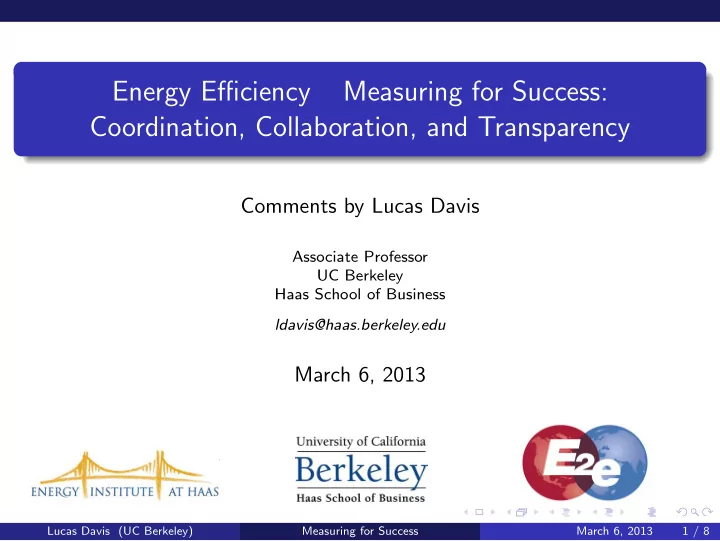

Energy Efficiency – Measuring for Success: Coordination, Collaboration, and Transparency Comments by Lucas Davis Associate Professor UC Berkeley Haas School of Business ldavis@haas.berkeley.edu March 6, 2013 Lucas Davis (UC Berkeley) Measuring for Success March 6, 2013 1 / 8 g r b g
ANNUAL POWER CONFERENCE ON ENERGY RESEARCH AND POLICY SPONSORED BY MARCH 22, 2013 Alameda Municipal Power California Energy Commission California Independent System Operator California Public Utilities Commission Calpine Corporation Chevron Corporation City of Palo Alto Utilities Consulate General of Canada Pacifi c Gas & Electric Sacramento Municipal Utilities District San Diego Gas & Electric Southern California Edison Lucas Davis (UC Berkeley) Measuring for Success March 6, 2013 2 / 8
Limited Evidence California has spent $15 billion on energy-efficiency over the last 30 years. Yet we know very little about what works and doesn’t work. Lucas Davis (UC Berkeley) Measuring for Success March 6, 2013 3 / 8 jpg
Engineering Analyses Most of what we know comes from engineering analyses. Source: McKinsey and Company, “Unlocking Energy Efficiency in the U.S. Economy”. Lucas Davis (UC Berkeley) Measuring for Success March 6, 2013 4 / 8 j g
Actual Savings May Be Smaller than Engineering Estimates Electricity Consumption 5 0 Kilowatt Hours Per Month −5 −10 −15 −12 −10 −8 −6 −4 −2 0 2 4 6 8 10 12 Months Before and After Replacement Source: Davis, Fuchs, and Gertler, “Cash for Coolers”, 2012. Lucas Davis (UC Berkeley) Measuring for Success March 6, 2013 5 / 8
Many Participants Are Free Riders Program Participation 2.5 Subsidy falls from $170 to $110 Percentage of Households Participating 2 Subsidy falls from $110 to $30 Minimum 1.5 to participate Subsidy falls from $30 to $0 1 .5 0 0 50 100 150 200 250 300 Average Historical Electricity Consumption (kWh) Source: Boomhower and Davis, “Free Riders”, 2013. Lucas Davis (UC Berkeley) Measuring for Success March 6, 2013 6 / 8
How to Ensure that Programs Reduce Energy Use? Three Easy Steps Collect data Make these data publicly available Design programs to facilitate evaluation Lucas Davis (UC Berkeley) Measuring for Success March 6, 2013 7 / 8 p jpg / / 3
Learn from Google Evidence-Based Decision Making Google doesn’t do anything without rigorous evaluation. When spending taxpayer dollars we should have the same approach. Lucas Davis (UC Berkeley) Measuring for Success March 6, 2013 8 / 8 / /
Recommend
More recommend